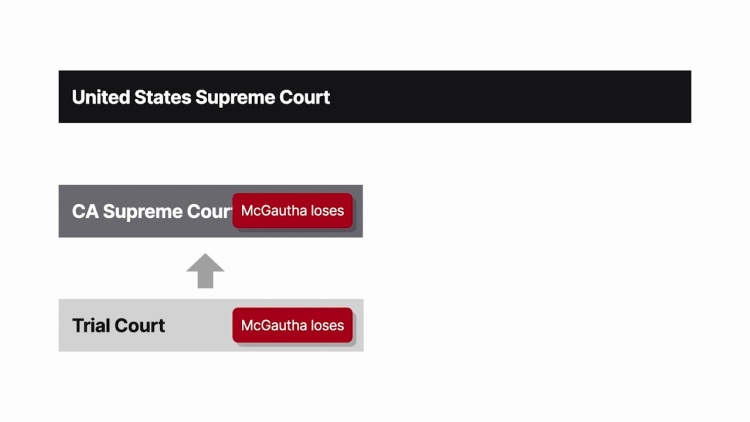McGautha v. California
United States Supreme Court
402 U.S. 183, 91 S. Ct. 1454, 28 L. Ed. 2d 711 (1971)
- Written by Robert Cane, JD
Facts
McGautha (defendant) was found guilty of murder for his role in an armed robbery in which a victim was shot and killed. McGautha committed the robbery and murder with the aid of Wilkinson, his codefendant. After the guilty verdict was rendered, the jury held a penalty trial. Wilkinson and McGautha both testified before the jury. Wilkinson testified to his rough upbringing and tough life. He also testified to the fact that McGautha had shot and killed the murder victim. Several witnesses called by Wilkinson supported Wilkinson’s testimony. Two witnesses testified to Wilkinson’s good character. In his testimony, McGautha testified that the murder weapon belonged to him but that Wilkinson had killed the murder victim. He also testified to the fact that he had had a rough life. McGautha admitted to participating in two prior robberies and to one prior conviction for murder, which he claimed was self-defense. McGautha called no witnesses on his behalf. The court instructed the jurors that they had absolute discretion to determine the penalties for the two men. The jury returned a verdict of life imprisonment for Wilkinson and a death sentence for McGautha. In a separate case, Crampton (defendant) was found guilty for the murder of his wife and was sentenced to death in a single trial. The jury was not given standards to use to determine whether the death penalty was just. Crampton left a mental hospital two months before the murder because he wanted to attend a funeral. He then refused to return to the mental hospital. Prior to the murder, Crampton spent three days on a crime spree while high on amphetamines with William Collins, who Crampton had met in prison. On the night of the murder, Collins dropped Crampton off at the home of Crampton’s wife. Crampton had previously threatened his wife’s life and believed she was having an affair. After the murder, Crampton was arrested for driving a stolen car in which police found the murder weapon. During trial, Crampton’s mother testified as to Crampton’s troubled childhood and adult life marred by drug addiction. Crampton’s attorney introduced evidence to show he was mentally insane, but Crampton was found both legally and medically sane. The United States Supreme Court consolidated both cases after granting certiorari in each.
Rule of Law
Issue
Holding and Reasoning (Harlan, J.)
What to do next…
Here's why 899,000 law students have relied on our case briefs:
- Written by law professors and practitioners, not other law students. 47,000 briefs, keyed to 994 casebooks. Top-notch customer support.
- The right amount of information, includes the facts, issues, rule of law, holding and reasoning, and any concurrences and dissents.
- Access in your classes, works on your mobile and tablet. Massive library of related video lessons and high quality multiple-choice questions.
- Easy to use, uniform format for every case brief. Written in plain English, not in legalese. Our briefs summarize and simplify; they don’t just repeat the court’s language.





